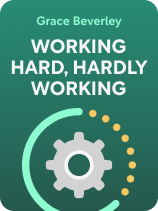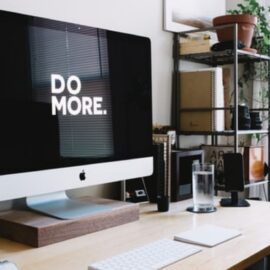

This article is an excerpt from the Shortform book guide to "Working Hard, Hardly Working" by Grace Beverley. Shortform has the world's best summaries and analyses of books you should be reading.
Like this article? Sign up for a free trial here.
Are productivity and self-care opposites? Do you have to choose between the two, or can you enjoy both?
The word “productivity” typically doesn’t bring to mind self-care behaviors such as sleeping in and enjoying a leisurely meal with friends. But, Grace Beverley’s Working Hard, Hardly Working insists that self-care and productivity aren’t opposites—they actually require each other.
Continue reading for an overview of this book that might inspire you to reset your lifestyle.
Overview of Working Hard, Hardly Working
Grace Beverley’s Working Hard, Hardly Working argues that you can improve your life and avoid burnout by recognizing that productive work leaves you with more time for self-care, and self-care boosts your productivity by energizing you.
(Shortform note: Beverley doesn’t explicitly define “self-care,” but we can infer from her descriptions throughout the book that she sees self-care as effectively meeting your physical and emotional needs. This view aligns with medical experts’ definition of self-care as supporting your body and mind, such as by regularly exercising, nurturing positive relationships, and scheduling time to relax. While Beverley primarily discusses self-care in the context of work and productivity, these medical experts frame self-care as a way to maintain your overall mental health. They explain that while self-care doesn’t cure mental health illnesses (such as anxiety and depression), it can help you manage these illnesses.)
Working Hard, Hardly Working (2022) is the first book by Beverley, a British entrepreneur. She began her career as a social media influencer, posting fitness and health advice on Instagram and YouTube. Later, she launched two companies: TALA, which sells sustainable clothing, and Shreddy, which offers fitness classes and meal plans. The insights and tips she shares in her book stem from her experiences learning to maintain a healthy work-life balance while serving as CEO of these companies.
We’ll begin by examining several features of modern life that contribute to overwork and burnout, particularly among young people. Then, we’ll turn to solutions, exploring Beverley’s insights on how to overcome the shame that many of us associate with self-care. We’ll also discuss how to build routines that improve your self-care and productivity.
The Problem: Overwork and Burnout
According to Beverley, many Gen Zers and Millennials are burned out. She argues that three features of life today contribute to the problem of burnout among young people.
Feature 1: Our Culture of Overwork
Beverley says that our culture of overwork—which frames productivity as a measure of your value—pressures young people to constantly earn money with “side gigs” instead of enjoying their downtime. For instance, someone who enjoys crafting in their free time might feel like they should start selling everything they make on Etsy.
Feature 2: Continuous Access to Technology and Social Media
Today, people have continuous access to technology. According to Beverley, this contributes to our culture of overwork in two main ways. First, continuous access to laptops and phones makes it possible and tempting to work during time off.
Second, social media platforms that are popular among Gen Zers and Millennials glorify overworking. Our culture of overwork proliferates on platforms such as TikTok and Instagram. People flaunt their productivity and accomplishments in their posts, contributing to the belief that it’s normal and noble to overwork. Because social media is accessible 24/7, young people have a hard time escaping our culture of overwork and its messages about productivity.
Feature 3: Economic Uncertainty
Beverley argues that economic uncertainty makes Gen Zers and Millennials feel like they need to constantly work so they can make enough to feel financially secure. She notes that recent events, such as the Covid-19 pandemic, have contributed to this economic uncertainty.
The Solution: Stop Seeing Self-Care and Productivity as Opposites
Beverley says that self-care is the antidote to overwork. You need to nurture your physical and mental health so productivity doesn’t burn you out. However, she acknowledges that engaging in self-care is often easier said than done. She emphasizes two common barriers to regularly engaging in self-care:
Barrier 1: Shame. We tend to feel ashamed about engaging in self-care due to our belief that it’s lazy and indulgent. Therefore, we avoid practicing self-care.
Barrier 2: Limited time. It’s challenging to carve out time for self-care when we’re busy with work, chores, and other obligations.
Beverley says you can overcome these barriers by no longer seeing self-care and productivity as opposites. Specifically:
- Overcome the barrier of shame by recognizing that self-care supports productivity and vice versa.
- Overcome the barrier of limited time by integrating self-care time into productivity time.
Let’s further explore how to overcome these two barriers.
How to Overcome the Barrier of Shame
Beverley recommends overcoming the shame you associate with self-care by dissolving the conceptual barrier between self-care and productivity. Stop seeing self-care as laziness and indulgence—the opposite of productivity. Instead, see self-care as productive. It restores your mental and physical energy, boosting your overall productivity. For example, a well-rested and mentally healthy songwriter will be able to efficiently produce meaningful songs.
Furthermore, see productivity as a form of self-care. When you work productively, you’re caring for yourself by leaving more time for replenishing activities, such as hobbies. Additionally, productive work sessions can leave you feeling energized—and pursuing energizing experiences is a form of self-care.
How to Overcome the Barrier of Limited Time
Beverley says you can overcome the barrier of limited time by integrating productivity time with self-care time. Do this by taking care of yourself even when you’re working productively. For example, when working on a project with a tight deadline, remember to eat nourishing meals and take occasional breaks.
Strategies for Improving Your Self-Care and Productivity
We’ll explore four of Beverley’s strategies for setting up cycles of productivity and self-care that support each other:
- Make your work more enjoyable.
- Meet your needs while you’re in flow (a state of enjoyable focus).
- Engage in self-care-only time.
- Use your work time wisely.
Strategy 1: Make Work More Enjoyable
Beverley says you can engage in self-care while working by making your work more enjoyable. That way, your time spent working productively won’t be depleting—instead, the joy you get from working will energize and satisfy you.
Let’s explore three of Beverley’s tips for making your work more enjoyable.
Tip 1: Incorporate Satisfying Tasks Into Your Workday
First, Beverley recommends ensuring that your workday involves many satisfying tasks (what she calls “micro-passions”). When you fill every day with multiple satisfying tasks, those days amount to a satisfying life.
To implement this tip, make a list of work-related tasks you find satisfying. Then, make a plan to incorporate more of those tasks into your typical workday. Beverley notes that this may require making large changes, such as asking your boss for additional (or different) responsibilities or pursuing professional development that will improve your skills. If those changes aren’t possible, it could be a sign that you should switch roles or careers.
For example, imagine you’re a teacher who enjoys the tasks of supporting your colleagues and learning new teaching techniques. You could ask your boss if you can start mentoring new teachers, or you could seek out professional development opportunities that will expand your teaching skills. If these changes aren’t possible, consider switching to a role in which these satisfying tasks feature prominently, such as becoming an instructional coach (a teacher of teachers).
Tip 2: Make Your Work Original
Second, Beverley argues that we find work more satisfying when we complete tasks in an original way. She explains that when we leverage our unique strengths to create original work, the result is more valuable because someone else can’t easily replicate it. Feeling valuable in this way gives us joy and satisfaction.
How can you make your work original? Beverley says to engage in warm-ups (what she calls “creative triggers”) that will inspire you to think outside the box before you complete work tasks. Warm-ups she recommends include drawing something relevant to your work task, listening to a podcast on a related topic, and brainstorming relevant ideas with others.
For example, say you’re a musician who posts lessons about musical concepts on YouTube. You begin one workday by doodling on paper while listening to a song you want to teach. This warm-up gives you the idea to represent the song visually in your video for it, using rising lines to represent ascending melodies, falling lines to indicate descending ones, and wavy lines to show vibrato.
Tip 3: Set Yourself Up to Experience Flow
Beverley offers a third tip for making your workdays more enjoyable: experience flow. She explains that, according to psychologist Mihaly Csikszentmihalyi, flow is a state in which you’re deeply absorbed in a task. Beverley says that flow makes productivity a form of self-care because the feeling of being engrossed in a task is joyful and satisfying.
According to Csikszentmihalyi, you experience flow when you’re engaged in a task in which your skill level matches the level of challenge you feel. If you’re not experiencing flow because a task is too easy, you can enter flow by making the task more challenging. If you’re unable to access flow because a task is too difficult, improve your skills.
Beverley advises that it’s easiest to enter flow states when working on tasks that are already conducive to flow. Start by identifying tasks that have put you into a state of flow before. Think of instances in which you felt completely engaged in a work task, such as moments when you lost track of time.
Next, instead of waiting for flow to happen when you engage in these tasks, purposefully initiate flow. Engage in a brief warm-up activity (Beverley calls these “flow triggers”) that inspires you to work on the tasks you identified. For instance, say you’re a graphic designer who has experienced flow in the past when sketching logo ideas. You could initiate flow by looking at pictures of your favorite logos for inspiration before designing your own.
Strategy 2: Meet Your Needs While You’re in Flow
Making tasks more enjoyable isn’t the only way to engage in self-care while working; Beverley says you can also attend to your needs (physical and otherwise). We’ll focus on Beverley’s advice for taking care of your needs while you’re in a state of flow, specifically. Even though flow is an enjoyable state, Beverley warns that it can lead to overwork. Let’s explore two of Beverley’s tips for avoiding this.
Tip 1: Prepare to Meet Your Physical Needs
When you’re experiencing flow, you might be so absorbed in a task that you forget to take care of yourself. Therefore, before starting a task that’ll get you into flow, prepare to meet your physical needs. For instance, fill your water bottle in advance and make sure your workspace is comfortable.
Tip 2: Decide in Advance How Long to Spend in Flow
Furthermore, if you spend too much time in flow, you’ll become mentally and physically exhausted—Beverley calls this “overflow.” Therefore, set a time limit for your flow session in advance. Enforce this limit by ensuring you’ll know to stop when that time is up—for example, set up a desktop notification to remind you when your flow period has ended.
Strategy 3: Engage in Self-Care-Only Time
So far, we’ve explored how to integrate self-care and productivity by bringing self-care time into your work time. However, Beverley also says it’s important to engage in pure self-care outside of productivity time so you can regularly experience the benefits of work-free leisure. Remind yourself that self-care-only time still supports your productivity by leaving you feeling rejuvenated and ready to be productive.
Let’s explore two of Beverley’s tips for engaging in self-care-only time.
Tip 1: Discover What Self-Care Means to You
Beverley argues that there isn’t a single set of self-care activities that work for everyone, since we all have different needs and interests. Therefore, take time to experiment with various self-care activities. First, try out any activities that could be considered self-care—anything that feels good and could therefore leave you rejuvenated, such as playing a board game or photographing your pet. Keep a record of which activities have the most positive impact on your mental health and productivity. Then, make those your go-to self-care activities.
Tip 2: Schedule Self-Care-Only Time Before You Burn Out
Beverley says we typically only engage in self-care-only activities in reaction to symptoms of burnout (such as exhaustion). This self-care doesn’t prevent burnout, however—it just manages its symptoms. Fortunately, Beverley says you can prevent burnout and its symptoms by proactively scheduling self-care-only time and protecting that time.
For example, say you find reading romance novels rejuvenating. Commit to spending every Saturday morning reading romance novels for two hours, and protect this self-care time by doing your chores beforehand and turning down any social invitations that conflict with this time.
Strategy 4: Use Your Work Time Wisely
Making time for self-care is possible only if you use your work time productively. When you work effectively and efficiently, you can work fewer hours, leaving more time for self-care.
Let’s explore three of Beverley’s tips for using your work time productively.
Tip 1: Ditch the To-Do List for the Eisenhower Method
A conventional to-do list includes a lineup of tasks you must complete, whether they’re in order of importance or not. Beverley argues that to-do lists aren’t conducive to productivity because they fail to prioritize tasks. For instance, they might place unimportant tasks or tasks with far-off deadlines higher on the list than tasks that are important and time-sensitive. As a result, you waste your time on unimportant tasks and work more hours than you need to.
Beverley recommends the Eisenhower Method (EM) as a replacement for the traditional to-do list. The EM has you assess how crucial and pressing your tasks are so you can decide which to prioritize, which to delegate to others, and which to skip. Crucial tasks are important to complete at some point to achieve your long-term goals, while pressing tasks have upcoming deadlines. To implement the EM, follow these four steps:
First, complete crucial and pressing tasks. For example, if you’re a journalist, work first on a labor-intensive article with an impending deadline.
Second, complete tasks that are crucial but not pressing. For instance, work on a large article that’s due in several weeks.
Third, assign unimportant but pressing tasks to others. This will prevent you from working extra hours to complete these tasks. For example, if you’ll be leaving for vacation soon and it would be nice (both not necessary) to put an automatic vacation responder on your email, ask your assistant to draft it and set it up.
Finally, skip tasks that are both unimportant and not pressing—doing so will cut down on how many hours you have to work, leaving more time for self-care.
Tip 2: Engage in Deep Work
Once you’ve determined what tasks you must complete and in what order, ensure you work efficiently and effectively on those tasks by doing deep work. Beverley explains that, according to Cal Newport (Deep Work), who wrote a book about this concept, deep work is devoting focused, uninterrupted attention to a cognitively demanding task.
To engage in deep work, Beverley advises building long periods of work time into your schedule. She says it’s easier to engage in deep work when you focus for blocks of one to one and a half hours, with breaks in between.
Tip 3: Know When To Scrap Your Plans
While it’s valuable to build schedules and routines that support flow, prioritization, and deep work, Beverley provides the caveat that it’s important to recognize when your brain and body are simply incapable of productivity. These aren’t situations where you stop working simply because you want to—they’re situations when you need to stop working because you’re physically and/or mentally incapable of working productively (or even at all). For example, perhaps your partner suddenly broke up with you and you’re too sad and exhausted to work.
In cases when you need to stop working or take a long break, Beverley urges you to be kind to yourself. Don’t shame yourself for being less capable than usual and needing to engage in necessary self-care.

———End of Preview———
Like what you just read? Read the rest of the world's best book summary and analysis of Grace Beverley's "Working Hard, Hardly Working" at Shortform.
Here's what you'll find in our full Working Hard, Hardly Working summary:
- Why self-care and productivity require one another
- How to use your work time wisely and make work tasks more enjoyable
- How regular self-care can help you prevent burnout






